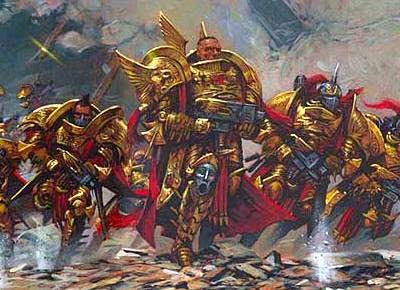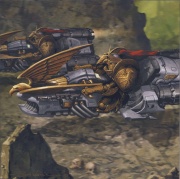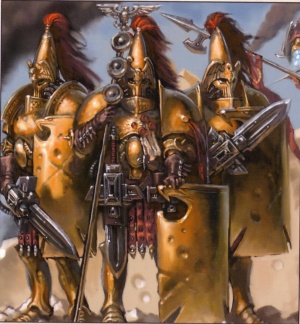40K Lore: The Adeptus Custodes
4 Minute Read
Nov 12 2014

Advertisement
Today adept we delve into the awe inspiring warriors who even the Astartes fear – The Adeptus Custodes
The Adeptus Custodes are the guardians of the Imperial Palace and the Golden Throne, as well as being the personal bodyguard to the Emperor. A small elite of three hundred Custodes, known as the Companions, form the Emperor’s personal bodyguard and never leave his side. Due to the vast size of the Imperial Palace, the Custodes always act as a defensive army. As of M41 the Custodes themselves never leave Terra, and only rarely leave the Palace.
It is the Adeptus Custodes that decide who may enter the throne room of the Emperor, and when.
Appearance and equipment
Generally, the Custodes are larger and more powerful than Space Marines, but the differences are only noticeably significant in a few specific cases.
The uniforms of the Custodians are traditional but effective: boots, leather breeches and long black cloaks. Their torsos are naked and corded with tattooed muscle. Their tall, brazen helmets, ominous and all-enclosing, give them a threatening and impersonal appearance; ancient and ornate, the helmets incorporate advanced protective equipment and communicators.
Originally the traditional colour of the Custodes was red; following the confinement of the Emperor after the defeat of Horus, it was changed to black.
The Custodes are renowned for carrying Guardian Spears, which have been carried by the Adeptus Custodes since long before the Emperor’s confinement. This weapon is closely associated with the Custodes, and is depicted on their banners and badges.
Outlook and training
Although the Custodes were among the first modified warriors to be created by the Emperor, they were never intended to be part of a conquering army; such a role was to be filled by the latter Astartes armies. This is revealed both in their mindset and training:
While Custodians share a genetic kinship with one another within the formation, they do not foster the same spirit of brotherhood that is instilled within the Astartes in order to function together as a unit. Indeed, each Custodian prepares and inspects his equipment individually, rather than on military parade.
The individuality of each Custodes is further promoted by the fact that the processes required to produce them is not as refined or as simple as that of the Astartes and thus are not “mass-produced” as the Astartes are; meaning that each Custodian is a unique investment for the Imperium.
One ritual that the Custodes do share is the recognition of mighty deeds, manifested in the awarding of names, which are added to the Custodian’s title to represent the actions he has performed in service to the Emperor (Constantin Valdor obtained 1932 names prior to the assault on Terra). Such names were inscribed onto the inside of the warrior’s battle armour as marks of individual pride.
The training of the Custodes also differed immensely from the Astartes, being bodyguards rather than soldiers. It is clear from their Blood Games that Custodians are trained in the arts of assassination – both improvised and advanced – in order to counter possible assassination attempts to the Emperor. It is common for several Custodians to be on detached duty for these Blood Games so that the organisation remains vigilant against developing threats.
Furthermore it is clear that the Custodes are also well versed in the political etiquette of Terra, and have been known to act outside of Imperial Law, to infiltrate influential Noble Houses and to investigate any potential threats (a role that an Astartes would never be expected to fulfil.)
This aspect of the Custodian mindset is advantageous, given that the Captain-General often shares a seat with the High Lords of Terra, which thus allows him to navigate the political maneuverings of the Imperium’s various agencies, while still remaining an awe-inspiring warrior.
So the eternal question – Custodian vs Astartes – place your bets!
Author: Larry Vela
Advertisement




